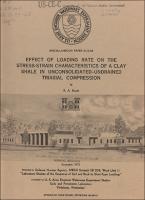Please use this identifier to cite or link to this item:
https://hdl.handle.net/11681/20752| Title: | Effect of loading rate on the stress-strain characteristics of a clay shale in unconsolidated-undrained triaxial compression |
| Authors: | United States. Defense Nuclear Agency Knott, Randy A. |
| Keywords: | Clay shales Q Tests (soils) Rock tests Rock mechanics Stress-strain relations Shear strength |
| Publisher: | Soils and Pavements Laboratory (U.S.) Engineer Research and Development Center (U.S.) |
| Description: | Miscellaneous Paper Abstract: The soil and rock mechanics community has become involved in the determination of dynamic material properties due to the concern over ground motions as imposed by shock loadings through earth materials. One method of determining some of the dynamic material properties of Pierre clay shale is to use a dynamic triaxial compression device. This study involved the conduct and analysis of a series of static and dynamic unconsolidated-undrained triaxial compression tests on NX-size core specimens of Pierre clay shale. These tests were conducted with constant confining pressures ranging from 0 to 4200 psi and had times to failure ranging from 6 msec to 4 min. Following an introductory chapter, a chapter on previous research is presented that includes a brief review of the history of laboratory soil and rock dynamic strength studies. The material tested is described in the next chapter which also presents the test results, Lateral deformation as well as vertical deformation measurements were made on the test specimens. Therefore, the bulk modulus, shear modulus, and Young's modulus could be and were calculated. Initial and tangent bulk moduli are presented showing static and dynamic trends. Three different Young's and shear moduli.were defined and results were presented to show static and dynamic trends in these moduli with increasing confining stress. Using the values of these moduli, Poisson's ratio was calculated. Static and dynamic yield and failure strengths were defined and presented showing the effects of confining stress. The strains at each of these stresses were also presented and static and dynamic data trends with increasing confining stress were examined. In addition, a limited analysis was conducted on failure mode, comparison of Pierre clay shale with Cucaracha clay shale dynamic triaxial data, residual strength, rock classification, and anisotropic properties. The results of the study were summarized by the use of rate factors or the dynamic to static ratio of comparable characteristics. This study of Pierre clay shale showed that loading rate can increase the value of failure strength as much as 3.5 times and can increase the value of initial moduli as much as 9.8 times. Further discussion is presented on some of the implications of the effect of loading rate on other stress-strain characteristics. Recommendations for further study on testing clay shales as well as on the handling of clay shale specimens both in the field and in the laboratory prior to their use in physical property tests were made. |
| Rights: | Approved for public release; distribution is unlimited. |
| URI: | http://hdl.handle.net/11681/20752 |
| Appears in Collections: | Miscellaneous Paper |
Files in This Item:
| File | Description | Size | Format | |
|---|---|---|---|---|
| MP-S-73-68.pdf | 26.49 MB | Adobe PDF |  View/Open |